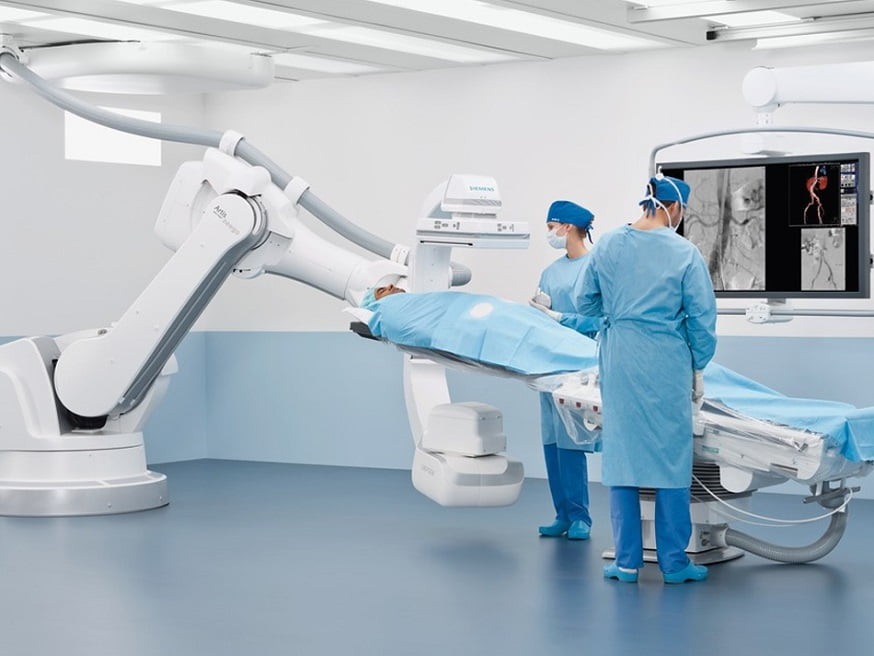The world’s first dual robotic surgery was performed last week at Hadassah Hospital Ein Kerem in Jerusalem, Israel. The 42-year-old patient who underwent the procedure will be able to walk again after a heavy steel frame had fallen on him.
The revolutionary dual robotic surgery, performed on April 23, repaired of a severe spinal fracture suffered by Aharon Schwartz, a factory worker who was injured when a steel object pinned him to the ground, fracturing his leg in two places and breaking six of his spinal vertebrae.
The pioneering, three-hour surgery took place in a state-of-the-art, $30 million operating room, according to Dr. Meir Liebergall, chairman of the Hadassah Medical Organization’s orthopedic department. Two robots, Siemens’ Artis Zeego and the Renaissance Guidance System, were involved in the surgery. Renaissance is a screw placement system which allows spinal implant placement with safety and accuracy, and was developed by Israeli company Mazor Robotics.
According to Hadassah’s president Ellen Hershkin, “the world’s first dual robot-assisted spinal surgery solidifies Hadassah’s reputation for world-class medical innovation and treatment.”
SEE ALSO: Revolutionizing The World Of Surgery
Mazor Robotics’ guidance systems enable surgeons to conduct spine and brain procedures in a precise manner. Founded in 2001, the company’s intuitive interface helps surgeons plan operations in a virtual 3D environment, creating a surgical blueprint for better accuracy.
Transforming spine surgery into a highly accurate procedure
According to Mazor Robotics, the Renaissance Guidance System “transforms spine surgery from freehand procedures to highly accurate, state-of-the-art procedures that may reduce fluoroscopy – even for minimally-invasive surgery, scoliosis, and other complex spinal deformity cases.”
The Siemens Artis Zeego robotic technology “enables smoother, swifter and trouble-free patient positioning and execution procedures,” according to Hadassah.
Sign up for our free weekly newsletter
SubscribeSEE ALSO: Inspired By Israeli Air Force Simulators, Former Pilots Develop 3D Simulator for Surgeons
Amal Khouri, director of Hadassah’s Orthopedic Hospitalization Center, provided real-time, 3D imaging during the surgical procedure, which eliminated the need for pre-surgery CT scans and post-surgery X-rays.
During the minimally invasive surgery, Mazor’s Renaissance robot communicated with Artis Zeego, while senior orthopedic surgeon Dr. Josh Schroeder led the Hadassah orthopedic team in the insertion of 11 pedicle screws into the patient’s spine “with clinical exactitude,” Hadassah says.
According to Liebergall, the patient is expected to completely recover from the surgery and will be walking again shortly.
Innovative platform for surgery born at the Technion
The story of Mazor Robotics began at the Technion – Israel’s Institute of Technology. The company was officially founded by Prof. Moshe Shoham and Eli Zehavi, but the work had begun years earlier with Shoham, the head of the Robotics Laboratory at the Technion, conducting research to develop an innovative platform for surgery.
Photos: Hadassah, Bigstock, Siemens, Mazor Robotics
Related posts

Editors’ & Readers’ Choice: 10 Favorite NoCamels Articles

Forward Facing: What Does The Future Hold For Israeli High-Tech?

Impact Innovation: Israeli Startups That Could Shape Our Future







Facebook comments